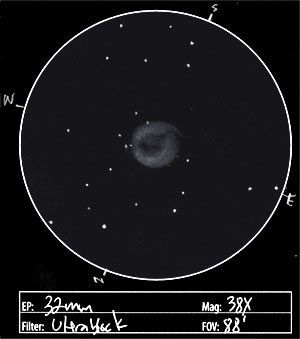
Observation Notes:
 This planetary nebula is huuuge. I really needed the ultrablock to find detail. Without the filter, it was just a slight brightening above the level of the sky. Overall, it was circular with a bit of a wisp running off the southeast side. It had a hollow appearance, with the northeast side being the brightest. It seemed open on the northwest and southeast sides. Overall, I estimated its diameter at 13'. Light pollution was heavy in the area, with 89-Aquarii (Mag. 4.7) being the faintest I could see naked-eye. I'm not at all pleased with the size of the nebula in my sketch. I think I condensed the star framework in the center, which resulted in the nebula appearing smaller in the sketch than it really was. Oy. I'll need to do this again another day. Also, I thought I detected an extension of nebulosity hanging into the middle from the southwest side, but I scrubbed it in too dark, and now it looks a bit like a bullseye. This is not quite right. Anyway, like I said, I need to do this one again.
This planetary nebula is huuuge. I really needed the ultrablock to find detail. Without the filter, it was just a slight brightening above the level of the sky. Overall, it was circular with a bit of a wisp running off the southeast side. It had a hollow appearance, with the northeast side being the brightest. It seemed open on the northwest and southeast sides. Overall, I estimated its diameter at 13'. Light pollution was heavy in the area, with 89-Aquarii (Mag. 4.7) being the faintest I could see naked-eye. I'm not at all pleased with the size of the nebula in my sketch. I think I condensed the star framework in the center, which resulted in the nebula appearing smaller in the sketch than it really was. Oy. I'll need to do this again another day. Also, I thought I detected an extension of nebulosity hanging into the middle from the southwest side, but I scrubbed it in too dark, and now it looks a bit like a bullseye. This is not quite right. Anyway, like I said, I need to do this one again.
Side note: I made another observation on the evening of September 30, 2005, from the Cinder Hills Overlook at Sunset Crater National Monument. I wasn't ready to make a sketch at the time, but I did note that without the Ultrablock filter, the central star along with a couple others flickered in and out of view on the surface of the nebula (seeing was horrible).
Factoids:
The Helix nebula lies about 450 light years away, making it one of the closest planetary nebulae. Distance estimates range from 85 to 590 light years. It is also one of the largest planetary nebulae, with a diameter of 16' for the main body of the nebula, while the outer halo extends to 28'. While bright, its large dimension keeps it from being an easy object for visual observation. There is no record that the Herschels observed or catalogued it. It was discovered by Karl Ludwig Harding before 1824.
| Subject | NGC 7293 - Helix Nebula | |
| Classification | Planetary Nebula | |
| Position* | Aquarius [RA: 22:29:36 / Dec: -20:48:00] | |
| Size* | 16'/28' | |
| Brightness* | 7.3 | |
| Date/Time | September 25, 2005 - 11:30 PM (September 26, 2005 - 06:30 UT) | |
| Observing Loc. | Flagstaff, AZ - Home | |
| Instrument | Orion SVP 6LT Reflector (150 mm dia./1200 mm F/L) | |
| Eyepieces/Mag. | 32 mm (38X) | |
| Conditions | Clear, calm, 53�F | |
| Seeing | ~3-4/10 | |
| Transparency | Mag 4.7 NELM (based on 89-Aquari) | |
| Sources | SEDS |
*Based on published data.





I really like image of the Helix neb.My question is:Do you have any color versions of the Helix?.
I visit your site often and look forward to seeing more of your work.
Good job!!!
Hi Andrew,
Thanks very much! Since this sketch of the Helix is based on a visual observation, I didn't detect any color in the nebula. Occasionally, I'll pick up hints of green in the brighter nebulae, not to mention star colors, and in those cases I'll try to indicate that in the sketch. But for this one, it was just a muted gray.
I've likewise enjoyed your site. Very nice work on the object-by-object astro photos. I look forward to more.
Jeremy